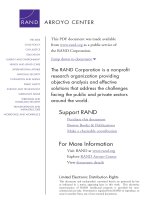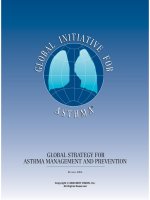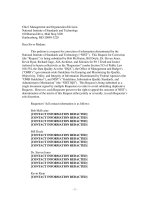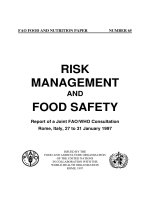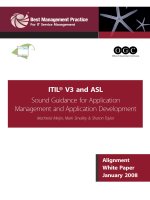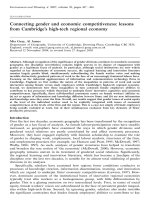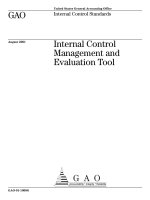strategic management and strategic competitiveness
Bạn đang xem bản rút gọn của tài liệu. Xem và tải ngay bản đầy đủ của tài liệu tại đây (455.32 KB, 32 trang )
Ch1-1
Chapter 1
Chapter 1
Strategic Management and
Strategic Management and
Strategic Competitiveness
Strategic Competitiveness
Michael A. Hitt
Michael A. Hitt
R. Duane Ireland
R. Duane Ireland
Robert E. Hoskisson
Robert E. Hoskisson
©2000 South-Western College Publishing
Ch1-2
Sustained Competitive Advantage
Sustained Competitive Advantage
Above-Average Returns
Above-Average Returns
Returns in excess of what an investor expects to
Returns in excess of what an investor expects to
earn from other investments with similar risk
earn from other investments with similar risk
Occurs when a firm develops a strategy that
Occurs when a firm develops a strategy that
competitors are not simultaneously implementing
competitors are not simultaneously implementing
Provides benefits which current and potential
Provides benefits which current and potential
competitors are unable to duplicate
competitors are unable to duplicate
Strategic Competitiveness
Strategic Competitiveness
Achieved when a firm successfully formulates
Achieved when a firm successfully formulates
and implements a value-creating strategy
and implements a value-creating strategy
Ch1-3
which are required for firms to achieve:
which are required for firms to achieve:
Above-Average Returns
Above-Average Returns
Strategic Competitiveness
Strategic Competitiveness
Sustained Competitive Advantage
Sustained Competitive Advantage
The Strategic Management Process
The Strategic Management Process
Involves the full set of:
Involves the full set of:
Actions
Actions
Commitments
Commitments
Decisions
Decisions
Ch1-4
The Strategic
The Strategic
Management
Management
Process
Process
The Strategic
The Strategic
Management
Management
Process
Process
Chapter 3
Internal
Environment
Chapter 2
External
Environment
Strategic Intent
Strategic Mission
Strategy Formulation Strategy Implementation
Chapter 4
Business-Level
Strategy
Chapter 5
Competitive
Dynamics
Chapter 6
Corporate-Level
Strategy
Chapter 8
International
Strategy
Chapter 9
Cooperative
Strategies
Chapter 7
Acquisitions &
Restructuring
Chapter 10
Corporate
Governance
Chapter 11
Structure
& Control
Chapter 12
Strategic
Leadership
Chapter 13
Entrepreneurship
& Innovation
Strategic
Inputs
Feedback
Strategic
Outcomes
Strategic
Strategic
Actions
Actions
Strategic
Competitiveness
Above Average
Returns
Ch1-5
Chapter One: Key Themes
Chapter One: Key Themes
•
Industrial Organization Model
Industrial Organization Model
•
Resource-Based Model
Resource-Based Model
Challenge of Strategic Management
Challenge of Strategic Management
Changing Competitive Landscape
Changing Competitive Landscape
Two Models of Superior Profitability
Two Models of Superior Profitability
Key Stakeholder Groups
Ch1-6
Competitive success is transient unless care is
taken to preserve competitive position
Only 16 of the 100 largest U.S. companies at
the start of the 20th century are still
identifiable today!
In a recent year, 44,367 businesses filed for
bankruptcy and many more U.S. businesses failed
Challenge of Strategic Management
Challenge of Strategic Management
Ch1-7
Best Stocks of the Decade
Best Stocks of the Decade
Challenge of Strategic Management
Challenge of Strategic Management
The goals of achieving
The goals of achieving
strategic competitiveness
strategic competitiveness
and earning above-
and earning above-
average returns are
average returns are
challenging
challenging
The performance of
The performance of
some companies more
some companies more
than meets strategic
than meets strategic
management's
management's
challenge
challenge
Ch1-8
•
Rapid technological changes
•
Rapid technology diffusions
•
Dramatic changes in
information and
communication technologies
•
Increasing importance of
knowledge
Fundamental nature of
competition is changing
The pace of change
is relentless
and increasing
Traditional industry
boundaries are
blurring, such as
•
Computers
•
Telecommunications
21st Century Competitive Landscape
21st Century Competitive Landscape
Ch1-9
The global economy is
changing
•
People, goods, services and
ideas move freely across
geographic boundaries
•
New opportunities emerge
in multiple global markets
•
Markets and industries
become more
internationalized
Traditional sources of
competitive advantage
no longer guarantee
success
New keys to success
include:
•
Flexibility
•
Innovation
•
Speed
•
Integration
21st Century Competitive Landscape
21st Century Competitive Landscape
1999 1998 Country Competitiveness
Index 1999
Competitiveness
Index 1998
1 1 Singapore 2.12 2.16
2 3 United States 1.58 1.41
3 2 Hong Kong 1.41 1.91
4 6 Taiwan 1.38 1.19
5 5 Canada 1.33 1.27
6 8 Switzerland 1.27 1.10
7 10 Luxembourg 1.25 1.05
8 4 United Kingdom 1.17 1.29
9 7 Netherlands 1.13 1.13
10 11 Ireland 1.11 1.05
11 15 Finland 1.11 0.70
12 14 Australia 1.04 0.79
13 13 New Zealand 10.1 0.84
14 12 Japan 1.00 0.97
15 9 Norway 0.92 1.09
16 17 Malaysia 0.86 0.59
17 16 Denmark 0.85 0.61
18 30 Iceland 0.59 -0.18
19 23 Sweden 0.58 0.25
20 20 Austria 0.37 0.37
21 18 Chile 0.57 0.57
22 19 Korea 0.46 0.39
23 22 France 0.44 0.25
24 27 Belgium 0.39 -0.03
25 24 Germany 0.37 0.15
26 25 Spain 0.16 0.02
Country Competitiveness Rankings
Country Competitiveness Rankings
A country’s
A country’s
competitiveness is
competitiveness is
achieved through the
achieved through the
accumulation of
accumulation of
individual firms’
individual firms’
strategic
strategic
competitiveness in
competitiveness in
the global economy
the global economy
Achieving improved
Achieving improved
competitiveness
competitiveness
allows a country's
allows a country's
citizens to have a
citizens to have a
higher standard of
higher standard of
living
living
21st Century Competitive Landscape
21st Century Competitive Landscape
Ch1-11
Alternative Models of Superior Returns
Alternative Models of Superior Returns
Resource-Based
Resource-Based
Model
Model
Industrial Organization
Industrial Organization
Model
Model
The External Environment
The External Environment
An Attractive Industry
An Attractive Industry
Strategy Formulation
Strategy Formulation
Assets and Skills
Assets and Skills
Strategy Implementation
Strategy Implementation
Superior Returns
Superior Returns
Resources
Resources
Capability
Capability
Competitive Advantage
Competitive Advantage
An Attractive Industry
An Attractive Industry
Strategy Implementation
Strategy Implementation
Superior Returns
Superior Returns
Ch1-12
I/O Model of Superior Returns
I/O Model of Superior Returns
The Industrial Organization model
suggests that above-average returns
for any firm are largely determined
by characteristics outside the firm.
This model largely focuses on
industry structure or attractiveness of
the external environment rather than
internal characteristics of the firm.
Ch1-13
Action required:
External
Environment
General Environment
Industry Environment
Competitive
Environment
Study the external
environment, especially
the industry environment.
I/O Model of Superior Returns
I/O Model of Superior Returns
Ch1-14
External
Environment
General Environment
Industry Environment
Competitive
Environment
An Attractive
Industry
An industry whose
structural characteristics
suggest above-average
returns are possible
Action required:
Locate an industry with
high potential for above-
average returns.
I/O Model of Superior Returns
I/O Model of Superior Returns
Ch1-15
External
Environment
General Environment
Industry Environment
Competitive
Environment
Attractive
Industry
An industry whose
structural characteristics
suggest above-average
returns are possible
Action required:
Identify strategy called for
by the industry to earn
above-average returns.
Selection of a strategy
linked with above-
average returns in a
particular industry
Strategy
Formulation
I/O Model of Superior Returns
I/O Model of Superior Returns
Ch1-16
External
Environment
General Environment
Industry Environment
Competitive
Environment
Attractive
Industry
An industry whose
structural characteristics
suggest above-average
returns are possible
Strategy
Formulation
Selection of a strategy
linked with above-
average returns in a
particular industry
Action required:
Develop or acquire assets
and skills needed to
implement the strategy.
Assets and Skills
Assets and skills
required to implement
a chosen strategy
I/O Model of Superior Returns
I/O Model of Superior Returns
Ch1-17
External
Environment
General Environment
Industry Environment
Competitive
Environment
Attractive
Industry
An industry whose
structural characteristics
suggest above-average
returns are possible
Strategy
Formulation
Selection of a strategy
linked with above-
average returns in a
particular industry
Assets and Skills
Assets and skills
required to implement
a chosen strategy
Action required:
Use the firm’s strengths
(its assets or skills) to
implement the strategy.
Strategy
Implementation
Selection of strategic
actions linked with
effective implementation
of the chosen strategy
I/O Model of Superior Returns
I/O Model of Superior Returns
Ch1-18
External
Environment
General Environment
Industry Environment
Competitive
Environment
Attractive
Industry
An industry whose
structural characteristics
suggest above-average
returns are possible
Strategy
Formulation
Selection of a strategy
linked with above-
average returns in a
particular industry
Assets and Skills
Assets and skills
required to implement
a chosen strategy
Action required:
Strategy
Implementation
Selection of strategic
actions linked with
effective implementation
of the chosen strategy
Superior Returns
Earning of above-
average returns
Maintain selected strategy
in order to outperform
industry rivals.
I/O Model of Superior Returns
I/O Model of Superior Returns
Ch1-19
The Resource-Based model suggests
that above-average returns for any
firm are largely determined by
characteristics inside the firm.
This model focuses on developing or
obtaining valuable resources and
capabilities which are difficult or
impossible for rivals to imitate.
Resource-Based Model of Superior Returns
Resource-Based Model of Superior Returns
Ch1-20
Resources
Inputs to a firm’s
production process.
Action required:
Identify firm resources.
Study strengths and weak-
nesses relative to rivals.
Resource-Based Model of Superior Returns
Resource-Based Model of Superior Returns
Ch1-21
Resources
Inputs to a firm’s
production process.
Action required:
Determine what firm
capabilities allow it to do
better than rivals.
Capability
Capacity for an integrated
set of resources to perform
a task or activity.
Resource-Based Model of Superior Returns
Resource-Based Model of Superior Returns
Ch1-22
Resources
Inputs to a firm’s
production process.
Capability
Capacity for an integrated
set of resources to
integratively perform a
task or activity.
Competitive
Advantage
Ability of a firm to
outperform its rivals
Action required:
Determine how firm’s
resources and capabilities
may create competitive
advantage.
Resource-Based Model of Superior Returns
Resource-Based Model of Superior Returns
Ch1-23
Resources
Inputs to a firm’s
production process.
Capability
Capacity for an integrated
set of resources to
integratively perform a
task or activity.
Competitive
Advantage
Ability of a firm to
outperform its rivals
An Attractive
Industry
Location of an
industry with
opportunities that can
be exploited by the
firm’s resources and
capabilities
Action required:
Locate an attractive
industry.
Resource-Based Model of Superior Returns
Resource-Based Model of Superior Returns
Ch1-24
Resources
Inputs to a firm’s
production process.
Capability
Capacity for an integrated
set of resources to
integratively perform a
task or activity.
Competitive
Advantage
Ability of a firm to
outperform its rivals
An Attractive
Industry
Location of an
industry with
opportunities that can
be exploited by the
firm’s resources and
capabilities
Action required:
Select strategy that best
exploits resources and
capabilities relative to
opportunities in environs.
Strategy
Formulation and
Implementation
Strategic actions taken to
earn above-average
returns
Resource-Based Model of Superior Returns
Resource-Based Model of Superior Returns
Ch1-25
Resources
Inputs to a firm’s
production process.
Capability
Capacity for an integrated
set of resources to
integratively perform a
task or activity.
Competitive
Advantage
Ability of a firm to
outperform its rivals
An Attractive
Industry
Location of an
industry with
opportunities that can
be exploited by the
firm’s resources and
capabilities
Action required:
Maintain selected strategy
in order to outperform
industry rivals.
Strategy
Formulation and
Implementation
Strategic actions taken to
earn above-average
returns
Superior Returns
Earning of above-
average returns
Resource-Based Model of Superior Returns
Resource-Based Model of Superior Returns
